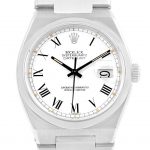The manual-winding distinction sets the Oysterdate apart from everything else Rolex has made since the introduction of the self-winding movement, and the Rolex Oysterdate Precision has always been a hand-wound watch. Incredibly, as the company that invented the Perpetual self-winding movement, the replica Rolex Oysterdate was never fitted with an automatic movement – even in the late 1980s, when the technology was inexpensive, ubiquitous, and fitted to virtually every other model outside the Cellini line. This unusual quirk added to the model’s cult status among collectors, helping to distinguish it from models such as the Oyster Perpetual and Date.
Inside, the 1225 movement grunts (or 1210 in some earlier examples). Cal. 1225 is a 17-jewel mechanism with a frequency of 21,600 vph. Despite the performance of this movement, it’s surprising that a watchmaker as progressive as Rolex retained a hand-wound movement until recently. Even Daytona, citing the need for a more complex chronograph movement, acquired the self-winding El Primero, while the clone Rolex Oysterdate Precision retained its manual-winding movement. 
Nothing was more of a headache for the Reference 6694 than the date function (and a non-Quickset one at that), and the Perpetual movement, which was never upgraded to automatic winding, gave it a sense of being forgotten by Rolex. One thing wearers shouldn’t forget, however, is that the Rolex Oysterdate Precision 6694 lacks the ability to set the date quickly, so adjusting multiple values of the calendar display does involve a slightly longer setup process. With that in mind, this straightforward approach only adds to Oysterdate’s appeal. In an increasingly automated world, it’s truly fascinating to do something as nostalgic as winding up a fine watch, especially a Rolex.
Best Rolex Oysterdate Precision 6694 Black Dial Stainless Steel
{ Comments are closed }